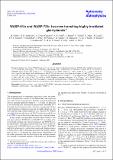Files in this item
WASP-64 b and WASP-72 b : two new transiting highly irradiated giant planets
Item metadata
| dc.contributor.author | Gillon, M. | |
| dc.contributor.author | Anderson, D. R. | |
| dc.contributor.author | Collier-Cameron, A. | |
| dc.contributor.author | Doyle, A. P. | |
| dc.contributor.author | Fumel, A. | |
| dc.contributor.author | Hellier, C. | |
| dc.contributor.author | Jehin, E. | |
| dc.contributor.author | Lendl, M. | |
| dc.contributor.author | Maxted, P. F. L. | |
| dc.contributor.author | Montalban, J. | |
| dc.contributor.author | Pepe, F. | |
| dc.contributor.author | Pollacco, D. | |
| dc.contributor.author | Queloz, D. | |
| dc.contributor.author | Segransan, D. | |
| dc.contributor.author | Smith, A. M. S. | |
| dc.contributor.author | Smalley, B. | |
| dc.contributor.author | Southworth, J. | |
| dc.contributor.author | Triaud, A. H. M. J. | |
| dc.contributor.author | Udry, S. | |
| dc.contributor.author | West, R. G. | |
| dc.date.accessioned | 2013-08-26T16:01:01Z | |
| dc.date.available | 2013-08-26T16:01:01Z | |
| dc.date.issued | 2013-04 | |
| dc.identifier | 66896066 | |
| dc.identifier | 0d71a15b-3f96-4d5f-98f0-758e16d8459e | |
| dc.identifier | 000317912000082 | |
| dc.identifier | 84875752597 | |
| dc.identifier.citation | Gillon , M , Anderson , D R , Collier-Cameron , A , Doyle , A P , Fumel , A , Hellier , C , Jehin , E , Lendl , M , Maxted , P F L , Montalban , J , Pepe , F , Pollacco , D , Queloz , D , Segransan , D , Smith , A M S , Smalley , B , Southworth , J , Triaud , A H M J , Udry , S & West , R G 2013 , ' WASP-64 b and WASP-72 b : two new transiting highly irradiated giant planets ' , Astronomy & Astrophysics , vol. 552 , A82 . https://doi.org/10.1051/0004-6361/201220561 | en |
| dc.identifier.issn | 0004-6361 | |
| dc.identifier.other | ORCID: /0000-0002-8863-7828/work/58531484 | |
| dc.identifier.uri | https://hdl.handle.net/10023/3996 | |
| dc.description.abstract | We report the discovery by the WASP transit survey of two new highly irradiated giant planets. WASP-64 b is slightly more massive (1.271 +/- 0.068 M-Jup) and larger (1.271 +/- 0.039 R-Jup) than Jupiter, and is in very-short (a = 0.02648 +/- 0.00024 AU, P = 1.5732918 +/- 0.0000015 days) circular orbit around a V = 12.3 G7-type dwarf (1.004 +/- 0.028 M-circle dot, 1.058 +/- 0.025 R-circle dot, T-eff = 5500 +/- 150 K). Its size is typical of hot Jupiters with similar masses. WASP-72 b has also a mass a bit higher than Jupiter's (1.461(-0.056)(+0.059) M-Jup) and orbits very close (0.03708 +/- 0.00050 AU, P = 2.2167421 +/- 0.0000081 days) to a bright (V = 9.6) and moderately evolved F7-type star (1.386 +/- 0.055 M-circle dot, 1.98 +/- 0.24 R-circle dot, T-eff = 6250 +/- 100 K). Despite its extreme irradiation (similar to 5.5 x 10(9) erg s(-1) cm(-2)), WASP-72 b has a moderate size (1.27 +/- 0.20 R-Jup) that could suggest a significant enrichment in heavy elements. Nevertheless, the errors on its physical parameters are still too high to draw any strong inference on its internal structure or its possible peculiarity. | |
| dc.format.extent | 13 | |
| dc.format.extent | 1561704 | |
| dc.language.iso | eng | |
| dc.relation.ispartof | Astronomy & Astrophysics | en |
| dc.subject | Planetary systems | en |
| dc.subject | WASP-64 | en |
| dc.subject | Photometric | en |
| dc.subject | Radial velocities | en |
| dc.subject | Spectroscopic | en |
| dc.subject | WASP-72 | en |
| dc.subject | QB Astronomy | en |
| dc.subject.lcc | QB | en |
| dc.title | WASP-64 b and WASP-72 b : two new transiting highly irradiated giant planets | en |
| dc.type | Journal article | en |
| dc.contributor.sponsor | Science & Technology Facilities Council | en |
| dc.contributor.sponsor | Science & Technology Facilities Council | en |
| dc.contributor.institution | University of St Andrews. School of Physics and Astronomy | en |
| dc.identifier.doi | 10.1051/0004-6361/201220561 | |
| dc.description.status | Peer reviewed | en |
| dc.identifier.grantnumber | ST/J001651/1 | en |
| dc.identifier.grantnumber | PP/F000065/1 | en |
This item appears in the following Collection(s)
Items in the St Andrews Research Repository are protected by copyright, with all rights reserved, unless otherwise indicated.

